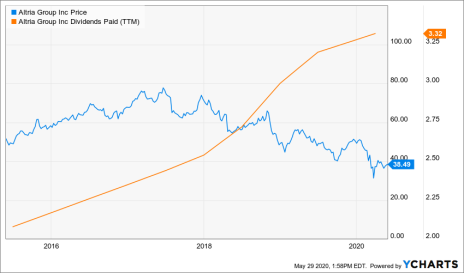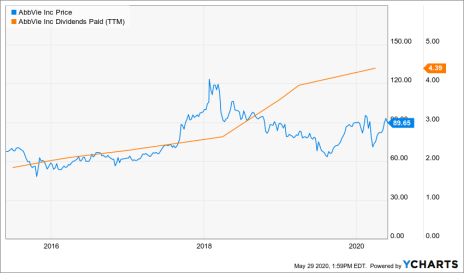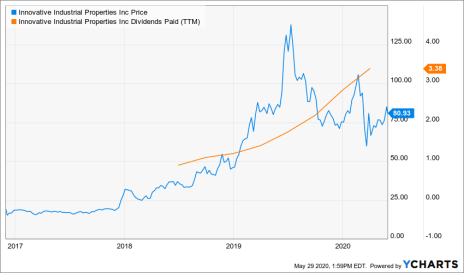Welcome to the inaugural issue of Cabot Income Advisor. It is my pleasure to share investment ideas that can provide you with a high income in today’s low interest rate world.
In this issue I highlight three stocks that are great buying opportunities right now for income investors. The stocks are chosen for their high yields, ability to generate attractive call premiums and the likelihood of capital appreciation over time.
While the market indexes have rebounded strongly from the March lows, many individual industries and stocks are still dirt cheap and high yielding, In fact, this is the best market in over a decade in which to find high yields in quality stocks.
Of course, the market is still dangerous and many high yielding stocks are in a precarious financial condition. Many will have to cut the dividend and the price will likely fall. While quality high yields are out there, stocks must be chosen wisely.
These three stocks are a great way to lock in high income and start to build your high income portfolio. Now is the time to embark on your journey to higher income and a more rewarding financial future. I look forward to being your trusted partner.
Cabot Income Advisor 520
[premium_html_toc post_id="206538"]
Welcome to Cabot Income Advisor
Welcome to the very first issue of Cabot Income Advisor.
The purpose of this newsletter is to provide you with investment ideas that generate a very high level of current income. The goal is to provide you with a double digit annual income with a reasonable level of risk, whereby you can maintain and grow your nest egg over time.
This newsletter kicks off in a crazy market. With the onset of the coronavirus and ensuing lockdowns, the market crashed 34% from the February high in record time. But, since the lows of March, the market has sprung back with a vengeance. The S&P 500 has shot up 37% from the low and is now just 11% from the all time high.
That’s hard to believe. The shutdown has crashed the economy. There are 39 million new unemployed. Several of the nation’s largest banks are forecasting a 30% to 40% contraction is second quarter GDP. There haven’t been numbers that ugly since the Great Depression. What’s the market thinking?
It’s important to remember that the market is forward looking. It’s pricing in the environment it anticipates will be here six to nine months down the road. By then, it sees a restarted economy making up for lost time and absolutely booming while the market is frolicking in trillions of Fed stimulus. That’s great stuff. I hope it happens. And the market usually gets it right.
That said, I’m not particularly bullish right now. Even with the most optimistic scenario, it will take a long time for the economy to get back to where it was. All those millions of unemployed people will have to trickle back to work, and then regain confidence. The staggering financial impact of the shutdown is yet to be realized. Many businesses will close. Certain industries that have been particularly hard hit will be slow to recover, and many companies will cut their dividends to free up much needed cash.
Under the circumstances, it’s hard to see the market making a new high in the near future. And there is only an 11% gap between the market today and new highs. At the same time, something can always go wrong. The virus could spread again later in the year, for instance.
Anything is possible of course. And the market tends to make fools of the greatest number of people. But I believe there is more downside risk than upside potential for the overall market in the near term.
That doesn’t mean there isn’t opportunity. While the overall market may have gotten ahead of itself right here, many individual sectors and stocks are still dirt cheap (see the article at the end). The wild market has created higher yields than have existed in a decade.
Certain stocks that have been knocked down are yielding 8%, 9% or even higher in some cases. Well-selected undervalued companies with safe dividends are creating the best income opportunities since the financial crisis. As well, the volatility is creating much higher call premiums from which to supplement your income.
In short, this is an environment that differs from normal in that it’s easier to get a high income but more difficult to protect your principle. As a result, I will not necessarily select the stock with the highest yields, but those that offer attractive income and limited downside in the event the market turns south.
What to Do Now
I found three strong investments that I am recommending as a BUY in this inaugural issue. I foresee this portfolio eventually having 10 to 15 different investments. Whatever you may want to allocate to this newsletter portfolio should be spread over 10 or more stocks. We will start with three. You don’t have to invest all at one time.
I also intend to write covered calls on all of these positions in the near term. The market volatility and upward bias has made call premiums very attractively priced.
Normally, I would simultaneously recommend buying the stock and selling a covered call (a buy/write). I can’t do that in this issue because it was written several days before it was sent to you. That’s because a brand new newsletter requires a few days to organize the original structure.
Options are extremely time sensitive and recommendations need to be acted on very quickly. Several days is too much time. For example, I could recommend selling a call that is priced at $2 today, but by the time you see the recommendation it could be $0.30. The opportunity would be lost.
You will receive this issue on Tuesday, June 2nd. You should expect recommendations to sell covered calls on these positions either that day or shortly after in the form of a “TRADE ALERT” that you receive via email and/or text, unless the market changes course by then. The alerts will need to be acted upon quickly in order to get a similar price.
Featured Action
This portfolio will start with BUY recommendations on three stocks. They all have strong yields but there are many stocks that pay a lot higher. These stocks are chosen for three primary reasons; the dividend should be safe (and not cut), they should hold up relatively well in case of another downturn, and they should thrive in the post-crisis environment.
These stocks also have the ability to generate high call premiums. As I mentioned, it isn’t that hard to find high income in this market. The tricky part is to find high income from stocks that will maintain and grow your principle as well.
Altria (MO)
Yield: 8.6%
Altria Group (MO) is the largest U.S. domestic cigarette maker and one of the largest in the world. The company is the domestic part of the old Philip Morris that spun off the international division in the form of Philip Morris International (PM) in 2008. Altria now operates primarily in the United States.
In addition to cigarettes, Altria also sells E-cigarettes, marijuana, beer, wine and smokeless products. Altria also owns a 10.2% stake in the world’s largest brewer Anheuser-Busch InBev (BUD). It may seem like a diversified company but it really isn’t. About 85% of net revenues are generated from cigarettes and the overwhelming majority of that is from its flagship Marlboro brand, which commands a stratospheric 40%-plus cigarette market share in the U.S.
That’s a problem because smoking is declining in this country at a rate of 4% to 6% per year. Of course, smoking has been declining at about 4% per year for decades, and for most of that time the stock has done very well. The rate of decline has increased in recent years primarily because of the popularity of E-cigarettes as an alternative. Altria took steps to compensate for the higher decline that have turned out disastrous.
In late 2018, Altria purchased a 45% stake in marijuana company Cronos (CRON) and E-cigarette company JUUL for $12.8 billion. JUUL was the dominant player in that market with about an 80% market share. But since the acquisition, E-cigarettes and JUUL in particular has been the subject of a regulatory blitzkrieg, primarily because of the product’s popularity with young people. It is now even questionable that the E-cigarette market will be allowed at all. Altria has since written off $8.6 billion of the investment.
Investors haven’t liked what is going on and the stock is now selling near a 5-year low. The stock is now more than 50% below the 2017 high and yielding a stratospheric 8.9%. I think it’s a great income opportunity.
Here’s the thing. Despite recent events, the company continues to grow earnings. Annual earnings growth averaged 11% over the past five years, and the company expects high single digit earnings growth going forward. Altria has been able to more than compensate for the volume slippage by raising prices on its iconic Marlboro brand, as well as buying back shares.
Even if JUUL and E-cigarettes get sued out of business, Altria will just sell more cigarettes. If E-cigarettes survive, Altria owns the biggest player. It’s got them coming or going. Plus, it’s likely to launch iQos, a heated tobacco E-cigarette, nationally in a joint venture with Philip Morris International (PM). That product could help deliver the growth it has been seeking. And the marijuana stake in Cronos should work out over the longer term as well.
But we’re buying this primarily for income. It’s a huge yield. But is it safe. After all, high yields like this can often be a red flag. But Altria has an 80% payout ratio that is in line with the historical average, and Altria (along with the time it was part of Philip Morris) has raised the dividend every year for the last 50 years.
Earnings continue to grow. In fact, people tend to smoke more in a recession. In the first quarter, cigarette volume increased 6% and adjusted earnings were 18.5% high than last year’s quarter.
The stock is undervalued in my opinion and should have little downside if the market tanks. Since the dividend is safe, it is a fantastic income opportunity that should not only deliver an obscene yield but should appreciate in value over time.
Altria Group (MO)
Security type: Common stock
Industry: Tobacco
Price: $39.05
52-week range: $30.95- $52.46
Yield: 8.6%
Profile: Altria with its dominant Marlboro brand is the number one cigarette company in the United States.
Positives
- The addictive nature of its products generates a high level of dependable cash flow and dividends.
- The iconic Marlboro brand enables the company to raise prices and offset volume declines.
- Atria continue to grow earnings despite recent troubles.
- The company has raised the dividend for 50 years in a row.
Risks
- The investment in JUUL is under siege by the regulators and the company has had to write off two thirds of the $12.8 billion investment.
- The U.S. cigarette industry is in a state of long term decline.
AbbVie Inc. (ABBV)
Yield: 5.25%
Health Care is a great business, especially during a recession. After all, you probably continue to take your medication regardless of the state of the economy. Health Care is also emerging as a hero of this pandemic. But the future is even brighter.
The population in the U.S. and around the world is older now than it has ever been, and it is getting still older at warp speed. In the U.S., about a third of the population is over 50 years old, and the fastest-growing segment of the population is 65 and older. As older people require more health care, the evolving demographic is a huge tailwind for the sector. Being poised ahead of a megatrend is a very big deal that bodes very well for future stock performance.
AbbVie is a cutting edge Biopharmaceutical company specializing in small molecule drugs. Spun off from Abbott Laboratories (ABT) in 2013, it has grown into the eighth largest pharmaceutical company in the world, primarily on the strength of its blockbuster biologic auto immune drug Humira, which is the world’s number one drug by far with annual sales of about $19 billion.
But despite being in an economically resilient industry that is poised to prosper mightily in the years ahead, the stock is still cheap. Now, it sells at a compelling valuation and pays a fat yield of over 5%.
The issue has been Humira. It had accounted for about 60% of revenues and the drug is facing increasing competition overseas where revenue there is declining. Overseas profits are expected to drop over 30% this year because of biosimilar competition. But in the U.S. (which accounts for three quarters of sales), Humira has patent protection until 2023.
The loss of Humira revenue had been spooking investors. The historically stellar performing stock fell 36% between early 2018 and early 2019. But AbbVie has invested heavily in the future and has drugs lined up to replace the falling Humira revenue.
The company believes recently launched cancer drugs Imbruvica and Venclexta can generate $9 billion in annual sales by 2025. In addition the company has two immunology drugs gaining approval this year that market research firm EvaluatePharma ranks the number 2 and number 3 drugs in its analysis of top new drug launches for 2020. AbbVie thinks the two drugs could bring in $10 billion a year by 2025.
And those are just the current all stars. AbbVie has what EvaluatePharma recently called the second best pipeline in all of pharma with many more drug launches in the next few years. And Humira isn’t likely to disappear. It’s still estimated to be one of the world’s top selling drugs until at least the middle of this decade.
To further diversify away from dependence on Humira, AbbVie purchased Ireland-based Allergan (AGN) for $63 billion and the deal closed this past April. The company is about half the size of AbbVie and features blockbuster facial treatment drug Botox. The acquisition will diversify the company away from Humira in the near term while the stellar pipeline gains traction.
This is one of the best and most advanced drug companies in the world with the enormous tailwind of the rapidly aging population. The longer term prognosis is fantastic as the company is effectively addressing the near term issues.
Investors, along with company insiders, had realized the value as the stock soared nearly 50% in the months before the bear market. Since the market bottom in March,
the stock has regained traction and is now near striking distance of the 52-week high ($92.10 vs. $97.86). But the stock is still a long way from the 2018 high of $123 and it current sells a bargain price of less than 10 times forward earnings.
The 5.12% yield is backed by a low payout ratio, rising earnings, and a better than 40 year track record of consecutive dividend hikes.
AbbVie Inc. (ABBV)
Security type: Common stock
Industry: Healthcare, pharmaceutical
Price: $91.17
52-week range: $62.55 - $97.86
Yield: 5.25%
Profile: AbbVie is one of the world’s largest biopharmaceutical companies that uses cutting edge biotechnology to produce therapies that treat some of the world’s most complex and serious diseases.
Positives
- The company is widely regarded to have one of the very best pipelines of potential new drugs and therapies drugs in the industry.
- AbbVie sells the world’s top selling drug, Humira, which should remain dominant for some time.
- The success of newly launched drugs and its merger with Allergan will reduce dependency on Humira.
- The aging population should be a huge tailwind for the industry.
Risks
- The top selling drug Humira accounts for a huge portion of revenues and is facing competition and falling revenues overseas and will face competition in the U.S. in 2023.
- Future performance is dependent largely on new the unproven success of new drugs therapies that are yet unproven.
Innovative Industrial Properties (IIPR)
Yield: 4.75%
Innovative Industrial Properties is a Real Estate Investment Trust (REIT) specializing in the acquisition and ownership of properties that grow legal marijuana for medical use in the United States. The company currently operates 56 properties in 15 states under long term leases.
The growth in marijuana is undeniable.
It is already the most used recreational drug in the world. And usage is growing like crazy. Global marijuana use has grown by 60% over the last decade and more than tenfold in the U.S. in the last 25 years. In fact, the U.S. is the marijuana capital of the world and currently accounts for anywhere from one third to one half of global consumption, depending on estimates.
But the industry has been born from a new trend toward legalization. It became legal throughout Canada in 2018. And the drug is now legal for medical use in 33 U.S. states and recreational use in 11 states. There is speculation about legalization nationwide at some point. But regardless of whether that happens or not, the trend toward more legalization is clear and undeniable.
The Arcview Group, an investment research firm, projects that sales of legal cannabis in the U.S. will go from $12.2 billion in 2019 to $31 billion by 2024. And that’s without further legalization. Increased legalization just got a whole lot more likely as states struggle with massive budget shortfalls resulting from the pandemic. They’ll be desperate for another source of tax revenue.
While the sale of legal marijuana is clearly trending higher, marijuana stocks have been on a rollercoaster ride, which lately has been down. But IIPR has vastly outperformed the sector. Since the IPO in December of 2016, IIPR has returned 379%, an average annual return of 57%. Over the same period, the largest marijuana REIT, MG Alternative Harvest ETFR (symbol MJ), has returned negative 43%.
There’s a good reason for the stellar outperformance of IIPR over the sector. Innovative is making money, and a lot of it, right now. Most marijuana companies in the early stages of the industry are struggling to show a profit. But IIPR has been ringing the register for years.
They have a great business model. Innovative purchases existing green houses and farms from marijuana growers and then leases the properties back to them. These companies often have trouble getting loans from banks and other conventional sources because marijuana is still not legal at the Federal level. Innovative, by buying the properties, gives them a much needed cash injection. The properties are leased back under long term contracts, currently with an average contract length of over 15 years, with triple net leases, where the operator pays for maintenance, taxes and insurance.
How has the formula worked? Over the last three years, the company’s revenues grew 1240% and earnings shot up 2000%. Over the same period, the dividend, currently yielding a hefty 5%, grew at an average annual rate of 93.75%.
Did you miss the boat? I don’t think so. The company acquires new properties and grows like crazy. Most REITs have hundreds of properties, or even thousands in some cases, but Innovative still has just 56.
Admittedly, IIPR is more of a sexy and aggressive stock than the others. It’s also true that it has more downside in the event that the market has another down leg. But given the safety and growth of the dividend, and the fact that the higher level of volatility commands higher call premiums, you should be rewarded for the volatility over time.
Innovative Industrial Properties Inc. (IIPR)
Security type: Real Estate Investment Trust (REIT)
Industry: Cannabis
Price: $85.44
52-week range: $40.21 - $139.53
Yield: 4.75%
Profile: Innovative Industrial is a REIT that purchases marijuana producing properties from growers of legal marijuana for medical use and leases them back under long term contracts.
Positives
- Marijuana sales are expected to continue growing at a very high rate and further legalization in the US is likely in the years ahead.
- IIPR benefits from industry growth without taking on much of the risk of industry peers.
- The company is making money now and has a much higher level of earnings growth than other REITs.
- Marijuana use is up in the pandemic and more legalization is increasingly likely as states struggle with fiscal deficits.
Risks
- Tenants take on high risk in a fiercely competitive industry in its infancy and could go bust.
- IIPR has a much high level of volatility and can fall a lot in a market downturn.
Income Calendar
Ex-Dividend Dates are in RED and italics. Dividend Payments Dates are in GREEN. Confirmed dates are in bold, all other dates are estimated. See the Guide to Cabot Income Advisor for an explanation of how dates are estimated.
The Misleading Market Index
There is tremendous opportunity in this market right now, especially for income investors. While the overall market, as represented by the S&P 500 index, has already rebounded sharply, there’s a lot more to the story.
The index performance isn’t that reflective of the overall market because it is over weighted in large technology companies, which are still doing well. The top five components of the S&P 500 are Microsoft (MSFT), Apple (AAPL), Amazon (AMZN), Facebook (FB) and Alphabet or Google (GOOG). These five stocks represent more than 20% of the index, which allocates by market capitalization.
Without this overrepresentation, the index would not have bounced back nearly this much, this fast. Many stocks in the index are still down 20% or 30% or even more in some cases. For example, the energy sector has been the worst performing sector of the market since the February highs. It’s down 28%. But stocks in that sector only represent 3% of the S&P 500 index.
The point is that there are many dividend stocks with prices that have fallen significantly and the yield on those stocks has risen. There are high yields all over the place right now. But you should be very careful. Usually prices fall for good reason, because business and cash flow has been hurt. Several of these high yielding stocks will have to cut the dividend to free up cash flow and survive. And much of the financial pain wrought by this lockdown-induced economic crash has not yet been realized.
The pickings aren’t as easy as they may seem. It won’t do you any good to buy a high yield only to see that dividend cut and the price fall down the road. There are attractive high yields out there. But the companies have to be well chosen with characteristics that make it likely that the dividend will not be cut. They need to have businesses and balance sheets to endure this crisis and thrive in the aftermath.
This is a great market for income. But you have to choose wisely.
The next Cabot Income Advisor issue will be published on June 24, 2020.
Cabot Wealth Network
Publishing independent investment advice since 1970.
CEO & Chief Investment Strategist: Timothy Lutts
President & Publisher: Ed Coburn
176 North Street, PO Box 2049, Salem, MA 01970 USA
800-326-8826 | support@cabotwealth.com | CabotWealth.com
Copyright © 2020. All rights reserved. Copying or electronic transmission of this information is a violation of copyright law. For the protection of our subscribers, copyright violations will result in immediate termination of all subscriptions without refund. No Conflicts: Cabot Wealth Network exists to serve you, our readers. We derive 100% of our revenue, or close to it, from selling subscriptions to its publications. Neither Cabot Wealth Network nor our employees are compensated in any way by the companies whose stocks we recommend or providers of associated financial services. Disclaimer: Sources of information are believed to be reliable but they are not guaranteed to be complete or error-free. Recommendations, opinions or suggestions are given with the understanding that subscribers acting on information assume all risks involved. Buy/Sell Recommendations: All recommendations are made in regular issues or email alerts or updates and posted on the private subscriber web page. Performance: The performance of this portfolio is determined using the midpoint of the high and low on the day following the recommendation. Cabot’s policy is to sell any stock that shows a loss of 20% in a bull market or 15% in a bear market from the original purchase price, calculated using the current closing price. Subscribers should apply loss limits based on their own personal purchase prices.





